Case Study Analysis: Peter Michelle's Type II Diabetes
VerifiedAdded on 2023/01/10
|7
|2423
|66
Case Study
AI Summary
This case study analyzes Peter Michelle, a patient with Type II Diabetes and obesity, using the Levett-Jones clinical reasoning cycle. The analysis assesses the patient's condition, identifies problems like hypertension, sleep apnea, and social withdrawal, and prioritizes nursing care goals. The paper details interventions, including dietary consultations, psychiatric counseling, and patient education on lifestyle changes. The study also emphasizes the importance of monitoring outcomes through blood glucose and weight assessments and evaluating the effectiveness of interventions. The reflection highlights the student's enhanced understanding of chronic illness management and the clinical reasoning cycle, demonstrating the ability to link theoretical frameworks to practical case applications and evidence-based research to create effective patient care plans.

Running head: CASE STUDY ANALYSIS
CASE STUDY ANALYSIS
Name of the Student:
Name of the University:
Author Note:
CASE STUDY ANALYSIS
Name of the Student:
Name of the University:
Author Note:
Paraphrase This Document
Need a fresh take? Get an instant paraphrase of this document with our AI Paraphraser
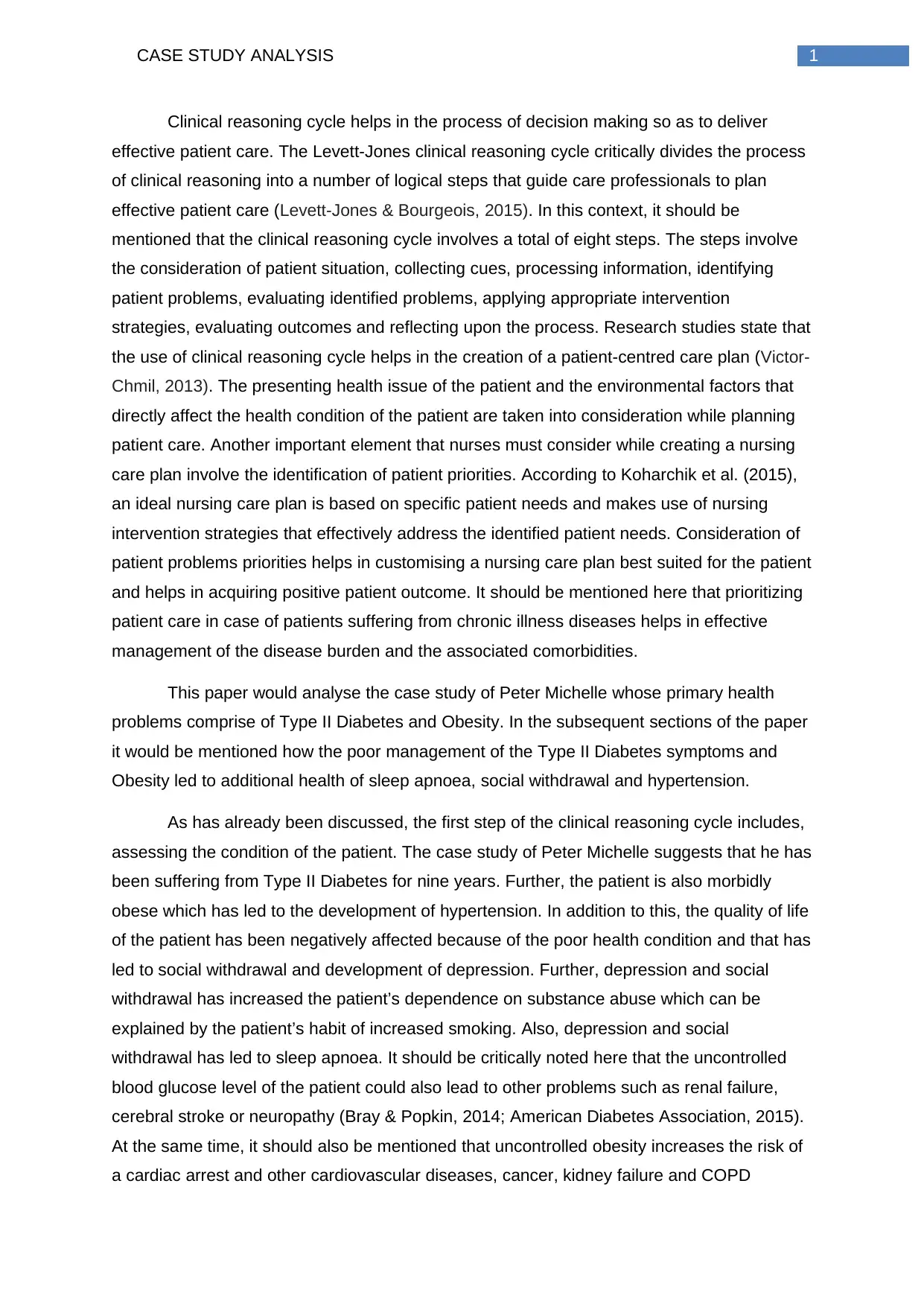
1CASE STUDY ANALYSIS
Clinical reasoning cycle helps in the process of decision making so as to deliver
effective patient care. The Levett-Jones clinical reasoning cycle critically divides the process
of clinical reasoning into a number of logical steps that guide care professionals to plan
effective patient care (Levett-Jones & Bourgeois, 2015). In this context, it should be
mentioned that the clinical reasoning cycle involves a total of eight steps. The steps involve
the consideration of patient situation, collecting cues, processing information, identifying
patient problems, evaluating identified problems, applying appropriate intervention
strategies, evaluating outcomes and reflecting upon the process. Research studies state that
the use of clinical reasoning cycle helps in the creation of a patient-centred care plan (Victor-
Chmil, 2013). The presenting health issue of the patient and the environmental factors that
directly affect the health condition of the patient are taken into consideration while planning
patient care. Another important element that nurses must consider while creating a nursing
care plan involve the identification of patient priorities. According to Koharchik et al. (2015),
an ideal nursing care plan is based on specific patient needs and makes use of nursing
intervention strategies that effectively address the identified patient needs. Consideration of
patient problems priorities helps in customising a nursing care plan best suited for the patient
and helps in acquiring positive patient outcome. It should be mentioned here that prioritizing
patient care in case of patients suffering from chronic illness diseases helps in effective
management of the disease burden and the associated comorbidities.
This paper would analyse the case study of Peter Michelle whose primary health
problems comprise of Type II Diabetes and Obesity. In the subsequent sections of the paper
it would be mentioned how the poor management of the Type II Diabetes symptoms and
Obesity led to additional health of sleep apnoea, social withdrawal and hypertension.
As has already been discussed, the first step of the clinical reasoning cycle includes,
assessing the condition of the patient. The case study of Peter Michelle suggests that he has
been suffering from Type II Diabetes for nine years. Further, the patient is also morbidly
obese which has led to the development of hypertension. In addition to this, the quality of life
of the patient has been negatively affected because of the poor health condition and that has
led to social withdrawal and development of depression. Further, depression and social
withdrawal has increased the patient’s dependence on substance abuse which can be
explained by the patient’s habit of increased smoking. Also, depression and social
withdrawal has led to sleep apnoea. It should be critically noted here that the uncontrolled
blood glucose level of the patient could also lead to other problems such as renal failure,
cerebral stroke or neuropathy (Bray & Popkin, 2014; American Diabetes Association, 2015).
At the same time, it should also be mentioned that uncontrolled obesity increases the risk of
a cardiac arrest and other cardiovascular diseases, cancer, kidney failure and COPD
Clinical reasoning cycle helps in the process of decision making so as to deliver
effective patient care. The Levett-Jones clinical reasoning cycle critically divides the process
of clinical reasoning into a number of logical steps that guide care professionals to plan
effective patient care (Levett-Jones & Bourgeois, 2015). In this context, it should be
mentioned that the clinical reasoning cycle involves a total of eight steps. The steps involve
the consideration of patient situation, collecting cues, processing information, identifying
patient problems, evaluating identified problems, applying appropriate intervention
strategies, evaluating outcomes and reflecting upon the process. Research studies state that
the use of clinical reasoning cycle helps in the creation of a patient-centred care plan (Victor-
Chmil, 2013). The presenting health issue of the patient and the environmental factors that
directly affect the health condition of the patient are taken into consideration while planning
patient care. Another important element that nurses must consider while creating a nursing
care plan involve the identification of patient priorities. According to Koharchik et al. (2015),
an ideal nursing care plan is based on specific patient needs and makes use of nursing
intervention strategies that effectively address the identified patient needs. Consideration of
patient problems priorities helps in customising a nursing care plan best suited for the patient
and helps in acquiring positive patient outcome. It should be mentioned here that prioritizing
patient care in case of patients suffering from chronic illness diseases helps in effective
management of the disease burden and the associated comorbidities.
This paper would analyse the case study of Peter Michelle whose primary health
problems comprise of Type II Diabetes and Obesity. In the subsequent sections of the paper
it would be mentioned how the poor management of the Type II Diabetes symptoms and
Obesity led to additional health of sleep apnoea, social withdrawal and hypertension.
As has already been discussed, the first step of the clinical reasoning cycle includes,
assessing the condition of the patient. The case study of Peter Michelle suggests that he has
been suffering from Type II Diabetes for nine years. Further, the patient is also morbidly
obese which has led to the development of hypertension. In addition to this, the quality of life
of the patient has been negatively affected because of the poor health condition and that has
led to social withdrawal and development of depression. Further, depression and social
withdrawal has increased the patient’s dependence on substance abuse which can be
explained by the patient’s habit of increased smoking. Also, depression and social
withdrawal has led to sleep apnoea. It should be critically noted here that the uncontrolled
blood glucose level of the patient could also lead to other problems such as renal failure,
cerebral stroke or neuropathy (Bray & Popkin, 2014; American Diabetes Association, 2015).
At the same time, it should also be mentioned that uncontrolled obesity increases the risk of
a cardiac arrest and other cardiovascular diseases, cancer, kidney failure and COPD
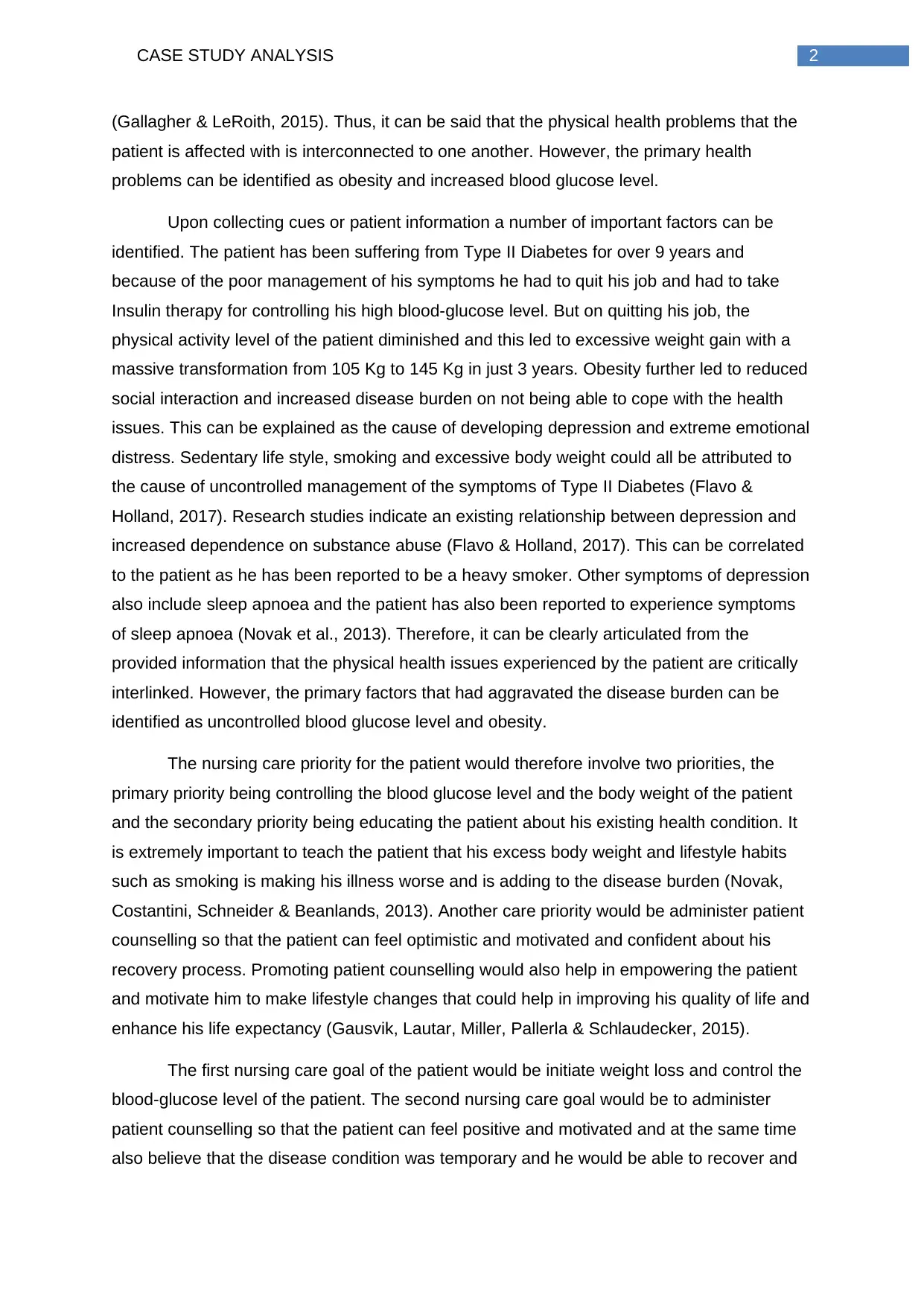
2CASE STUDY ANALYSIS
(Gallagher & LeRoith, 2015). Thus, it can be said that the physical health problems that the
patient is affected with is interconnected to one another. However, the primary health
problems can be identified as obesity and increased blood glucose level.
Upon collecting cues or patient information a number of important factors can be
identified. The patient has been suffering from Type II Diabetes for over 9 years and
because of the poor management of his symptoms he had to quit his job and had to take
Insulin therapy for controlling his high blood-glucose level. But on quitting his job, the
physical activity level of the patient diminished and this led to excessive weight gain with a
massive transformation from 105 Kg to 145 Kg in just 3 years. Obesity further led to reduced
social interaction and increased disease burden on not being able to cope with the health
issues. This can be explained as the cause of developing depression and extreme emotional
distress. Sedentary life style, smoking and excessive body weight could all be attributed to
the cause of uncontrolled management of the symptoms of Type II Diabetes (Flavo &
Holland, 2017). Research studies indicate an existing relationship between depression and
increased dependence on substance abuse (Flavo & Holland, 2017). This can be correlated
to the patient as he has been reported to be a heavy smoker. Other symptoms of depression
also include sleep apnoea and the patient has also been reported to experience symptoms
of sleep apnoea (Novak et al., 2013). Therefore, it can be clearly articulated from the
provided information that the physical health issues experienced by the patient are critically
interlinked. However, the primary factors that had aggravated the disease burden can be
identified as uncontrolled blood glucose level and obesity.
The nursing care priority for the patient would therefore involve two priorities, the
primary priority being controlling the blood glucose level and the body weight of the patient
and the secondary priority being educating the patient about his existing health condition. It
is extremely important to teach the patient that his excess body weight and lifestyle habits
such as smoking is making his illness worse and is adding to the disease burden (Novak,
Costantini, Schneider & Beanlands, 2013). Another care priority would be administer patient
counselling so that the patient can feel optimistic and motivated and confident about his
recovery process. Promoting patient counselling would also help in empowering the patient
and motivate him to make lifestyle changes that could help in improving his quality of life and
enhance his life expectancy (Gausvik, Lautar, Miller, Pallerla & Schlaudecker, 2015).
The first nursing care goal of the patient would be initiate weight loss and control the
blood-glucose level of the patient. The second nursing care goal would be to administer
patient counselling so that the patient can feel positive and motivated and at the same time
also believe that the disease condition was temporary and he would be able to recover and
(Gallagher & LeRoith, 2015). Thus, it can be said that the physical health problems that the
patient is affected with is interconnected to one another. However, the primary health
problems can be identified as obesity and increased blood glucose level.
Upon collecting cues or patient information a number of important factors can be
identified. The patient has been suffering from Type II Diabetes for over 9 years and
because of the poor management of his symptoms he had to quit his job and had to take
Insulin therapy for controlling his high blood-glucose level. But on quitting his job, the
physical activity level of the patient diminished and this led to excessive weight gain with a
massive transformation from 105 Kg to 145 Kg in just 3 years. Obesity further led to reduced
social interaction and increased disease burden on not being able to cope with the health
issues. This can be explained as the cause of developing depression and extreme emotional
distress. Sedentary life style, smoking and excessive body weight could all be attributed to
the cause of uncontrolled management of the symptoms of Type II Diabetes (Flavo &
Holland, 2017). Research studies indicate an existing relationship between depression and
increased dependence on substance abuse (Flavo & Holland, 2017). This can be correlated
to the patient as he has been reported to be a heavy smoker. Other symptoms of depression
also include sleep apnoea and the patient has also been reported to experience symptoms
of sleep apnoea (Novak et al., 2013). Therefore, it can be clearly articulated from the
provided information that the physical health issues experienced by the patient are critically
interlinked. However, the primary factors that had aggravated the disease burden can be
identified as uncontrolled blood glucose level and obesity.
The nursing care priority for the patient would therefore involve two priorities, the
primary priority being controlling the blood glucose level and the body weight of the patient
and the secondary priority being educating the patient about his existing health condition. It
is extremely important to teach the patient that his excess body weight and lifestyle habits
such as smoking is making his illness worse and is adding to the disease burden (Novak,
Costantini, Schneider & Beanlands, 2013). Another care priority would be administer patient
counselling so that the patient can feel optimistic and motivated and confident about his
recovery process. Promoting patient counselling would also help in empowering the patient
and motivate him to make lifestyle changes that could help in improving his quality of life and
enhance his life expectancy (Gausvik, Lautar, Miller, Pallerla & Schlaudecker, 2015).
The first nursing care goal of the patient would be initiate weight loss and control the
blood-glucose level of the patient. The second nursing care goal would be to administer
patient counselling so that the patient can feel positive and motivated and at the same time
also believe that the disease condition was temporary and he would be able to recover and
⊘ This is a preview!⊘
Do you want full access?
Subscribe today to unlock all pages.

Trusted by 1+ million students worldwide
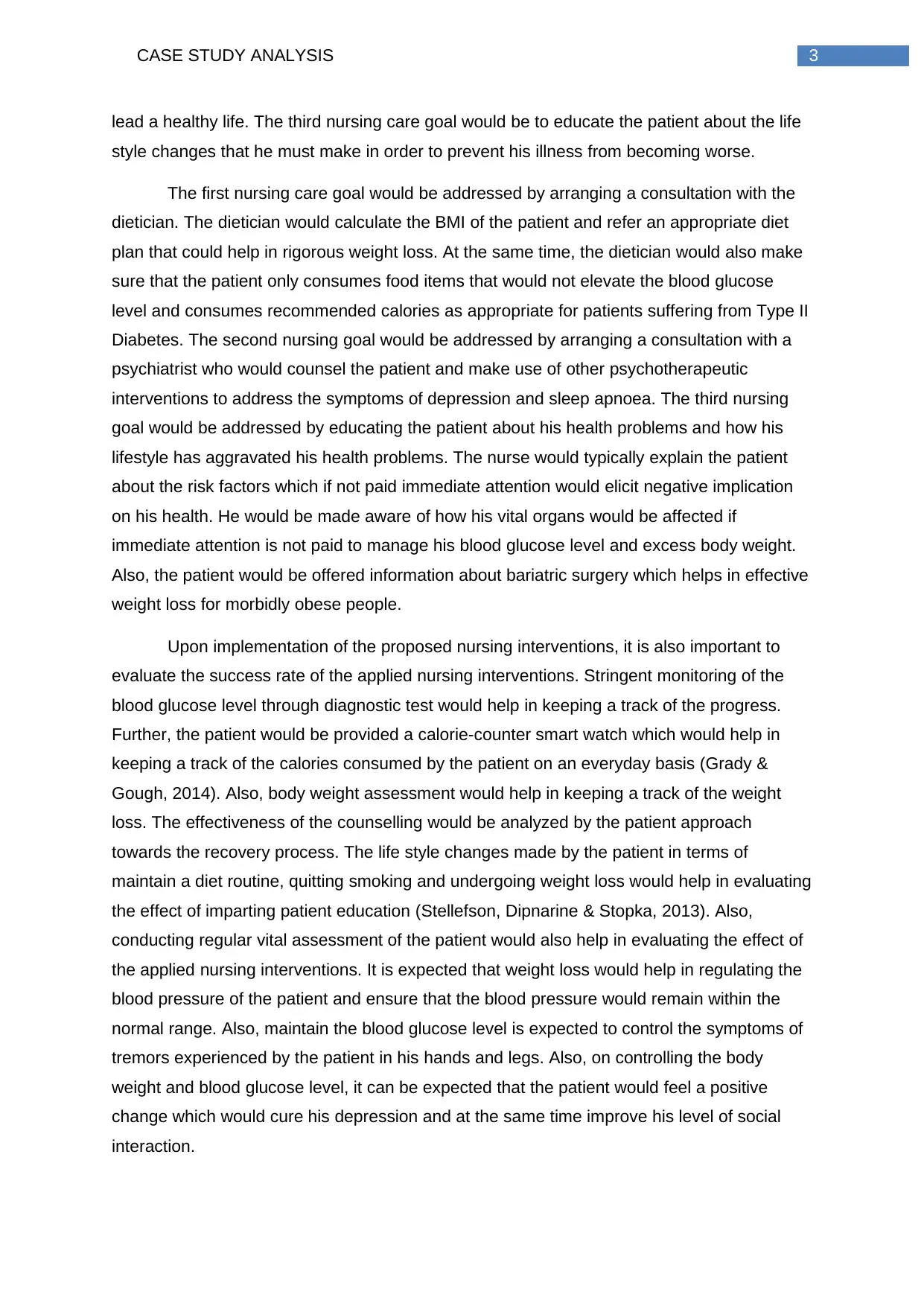
3CASE STUDY ANALYSIS
lead a healthy life. The third nursing care goal would be to educate the patient about the life
style changes that he must make in order to prevent his illness from becoming worse.
The first nursing care goal would be addressed by arranging a consultation with the
dietician. The dietician would calculate the BMI of the patient and refer an appropriate diet
plan that could help in rigorous weight loss. At the same time, the dietician would also make
sure that the patient only consumes food items that would not elevate the blood glucose
level and consumes recommended calories as appropriate for patients suffering from Type II
Diabetes. The second nursing goal would be addressed by arranging a consultation with a
psychiatrist who would counsel the patient and make use of other psychotherapeutic
interventions to address the symptoms of depression and sleep apnoea. The third nursing
goal would be addressed by educating the patient about his health problems and how his
lifestyle has aggravated his health problems. The nurse would typically explain the patient
about the risk factors which if not paid immediate attention would elicit negative implication
on his health. He would be made aware of how his vital organs would be affected if
immediate attention is not paid to manage his blood glucose level and excess body weight.
Also, the patient would be offered information about bariatric surgery which helps in effective
weight loss for morbidly obese people.
Upon implementation of the proposed nursing interventions, it is also important to
evaluate the success rate of the applied nursing interventions. Stringent monitoring of the
blood glucose level through diagnostic test would help in keeping a track of the progress.
Further, the patient would be provided a calorie-counter smart watch which would help in
keeping a track of the calories consumed by the patient on an everyday basis (Grady &
Gough, 2014). Also, body weight assessment would help in keeping a track of the weight
loss. The effectiveness of the counselling would be analyzed by the patient approach
towards the recovery process. The life style changes made by the patient in terms of
maintain a diet routine, quitting smoking and undergoing weight loss would help in evaluating
the effect of imparting patient education (Stellefson, Dipnarine & Stopka, 2013). Also,
conducting regular vital assessment of the patient would also help in evaluating the effect of
the applied nursing interventions. It is expected that weight loss would help in regulating the
blood pressure of the patient and ensure that the blood pressure would remain within the
normal range. Also, maintain the blood glucose level is expected to control the symptoms of
tremors experienced by the patient in his hands and legs. Also, on controlling the body
weight and blood glucose level, it can be expected that the patient would feel a positive
change which would cure his depression and at the same time improve his level of social
interaction.
lead a healthy life. The third nursing care goal would be to educate the patient about the life
style changes that he must make in order to prevent his illness from becoming worse.
The first nursing care goal would be addressed by arranging a consultation with the
dietician. The dietician would calculate the BMI of the patient and refer an appropriate diet
plan that could help in rigorous weight loss. At the same time, the dietician would also make
sure that the patient only consumes food items that would not elevate the blood glucose
level and consumes recommended calories as appropriate for patients suffering from Type II
Diabetes. The second nursing goal would be addressed by arranging a consultation with a
psychiatrist who would counsel the patient and make use of other psychotherapeutic
interventions to address the symptoms of depression and sleep apnoea. The third nursing
goal would be addressed by educating the patient about his health problems and how his
lifestyle has aggravated his health problems. The nurse would typically explain the patient
about the risk factors which if not paid immediate attention would elicit negative implication
on his health. He would be made aware of how his vital organs would be affected if
immediate attention is not paid to manage his blood glucose level and excess body weight.
Also, the patient would be offered information about bariatric surgery which helps in effective
weight loss for morbidly obese people.
Upon implementation of the proposed nursing interventions, it is also important to
evaluate the success rate of the applied nursing interventions. Stringent monitoring of the
blood glucose level through diagnostic test would help in keeping a track of the progress.
Further, the patient would be provided a calorie-counter smart watch which would help in
keeping a track of the calories consumed by the patient on an everyday basis (Grady &
Gough, 2014). Also, body weight assessment would help in keeping a track of the weight
loss. The effectiveness of the counselling would be analyzed by the patient approach
towards the recovery process. The life style changes made by the patient in terms of
maintain a diet routine, quitting smoking and undergoing weight loss would help in evaluating
the effect of imparting patient education (Stellefson, Dipnarine & Stopka, 2013). Also,
conducting regular vital assessment of the patient would also help in evaluating the effect of
the applied nursing interventions. It is expected that weight loss would help in regulating the
blood pressure of the patient and ensure that the blood pressure would remain within the
normal range. Also, maintain the blood glucose level is expected to control the symptoms of
tremors experienced by the patient in his hands and legs. Also, on controlling the body
weight and blood glucose level, it can be expected that the patient would feel a positive
change which would cure his depression and at the same time improve his level of social
interaction.
Paraphrase This Document
Need a fresh take? Get an instant paraphrase of this document with our AI Paraphraser
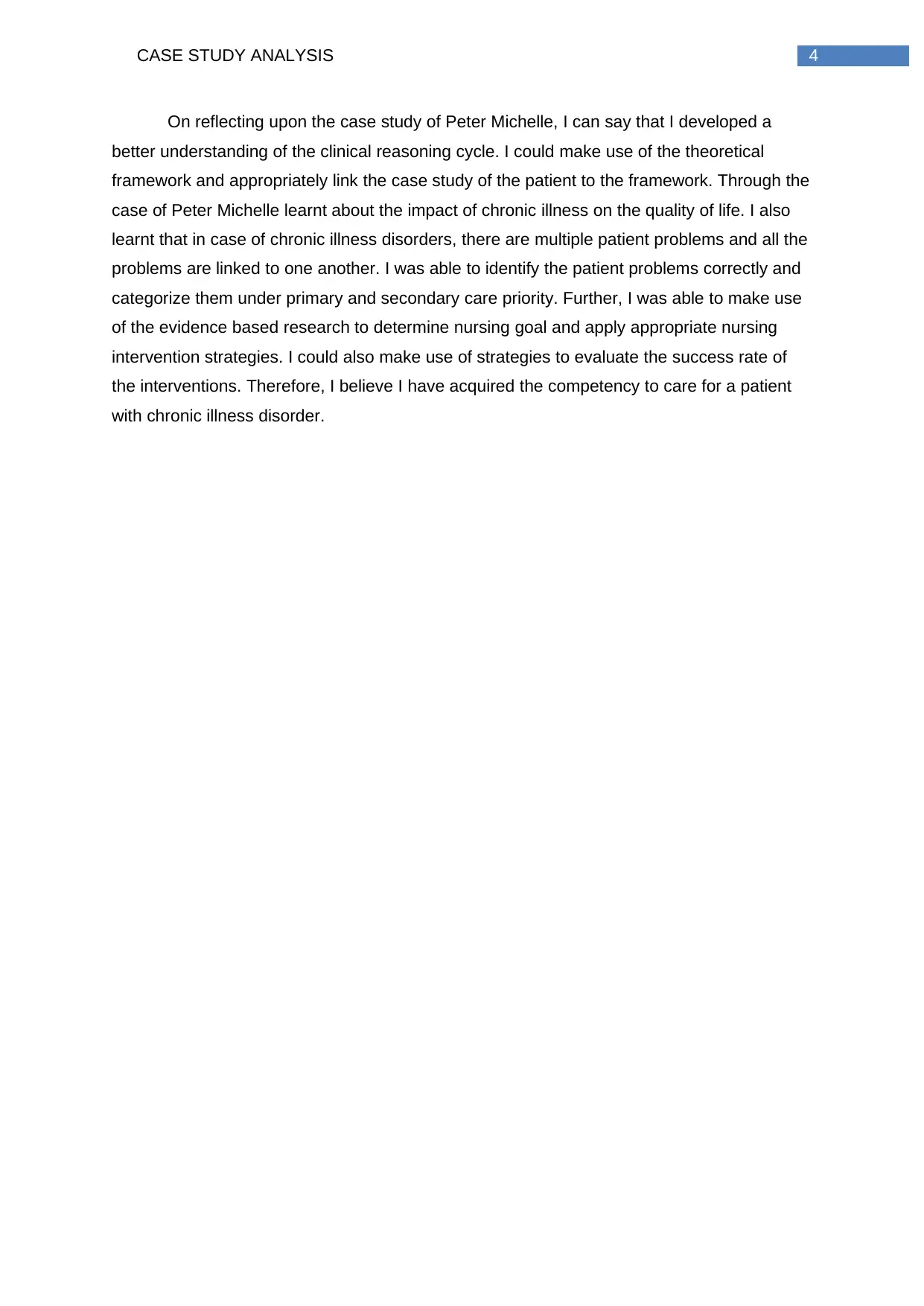
4CASE STUDY ANALYSIS
On reflecting upon the case study of Peter Michelle, I can say that I developed a
better understanding of the clinical reasoning cycle. I could make use of the theoretical
framework and appropriately link the case study of the patient to the framework. Through the
case of Peter Michelle learnt about the impact of chronic illness on the quality of life. I also
learnt that in case of chronic illness disorders, there are multiple patient problems and all the
problems are linked to one another. I was able to identify the patient problems correctly and
categorize them under primary and secondary care priority. Further, I was able to make use
of the evidence based research to determine nursing goal and apply appropriate nursing
intervention strategies. I could also make use of strategies to evaluate the success rate of
the interventions. Therefore, I believe I have acquired the competency to care for a patient
with chronic illness disorder.
On reflecting upon the case study of Peter Michelle, I can say that I developed a
better understanding of the clinical reasoning cycle. I could make use of the theoretical
framework and appropriately link the case study of the patient to the framework. Through the
case of Peter Michelle learnt about the impact of chronic illness on the quality of life. I also
learnt that in case of chronic illness disorders, there are multiple patient problems and all the
problems are linked to one another. I was able to identify the patient problems correctly and
categorize them under primary and secondary care priority. Further, I was able to make use
of the evidence based research to determine nursing goal and apply appropriate nursing
intervention strategies. I could also make use of strategies to evaluate the success rate of
the interventions. Therefore, I believe I have acquired the competency to care for a patient
with chronic illness disorder.
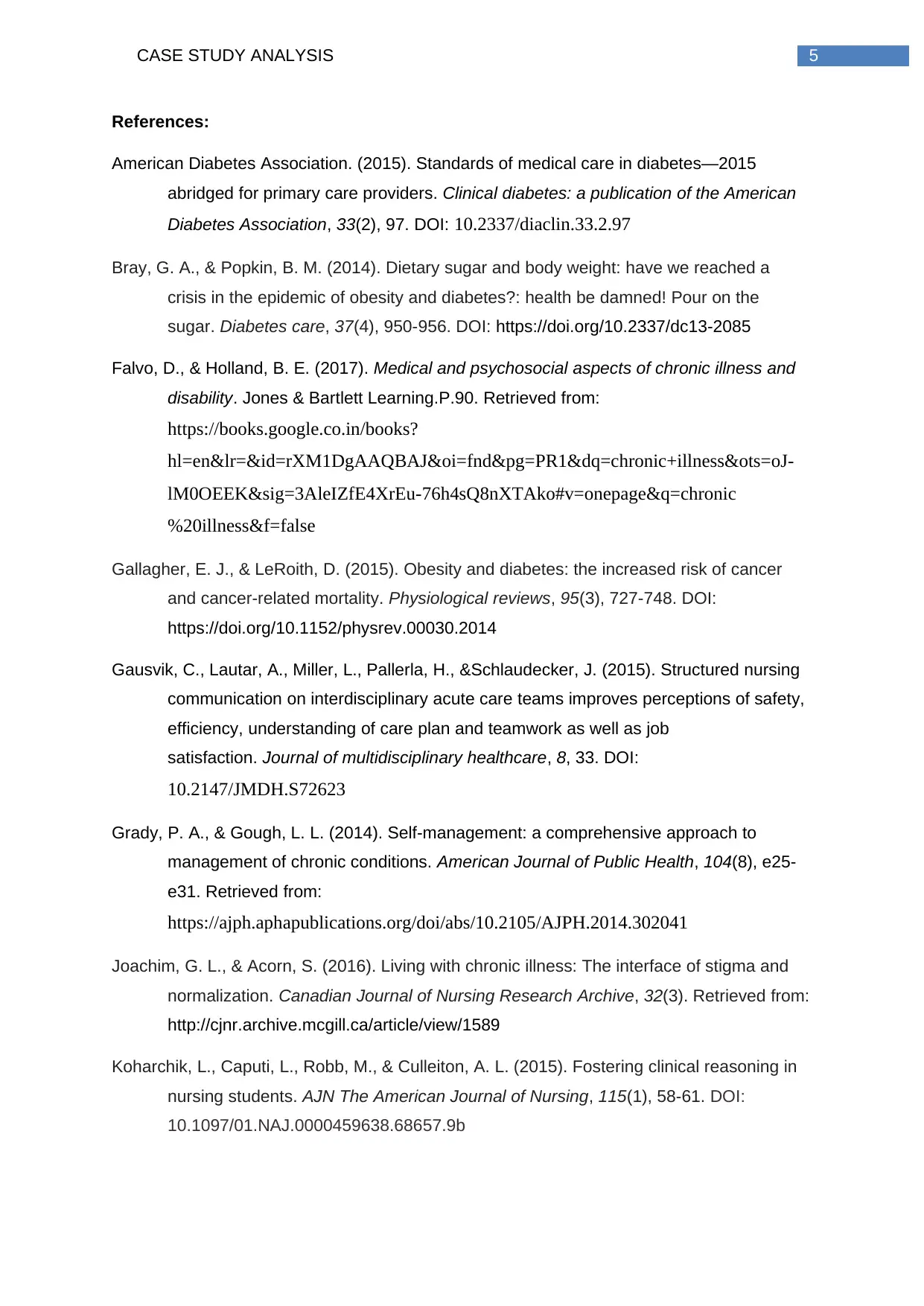
5CASE STUDY ANALYSIS
References:
American Diabetes Association. (2015). Standards of medical care in diabetes—2015
abridged for primary care providers. Clinical diabetes: a publication of the American
Diabetes Association, 33(2), 97. DOI: 10.2337/diaclin.33.2.97
Bray, G. A., & Popkin, B. M. (2014). Dietary sugar and body weight: have we reached a
crisis in the epidemic of obesity and diabetes?: health be damned! Pour on the
sugar. Diabetes care, 37(4), 950-956. DOI: https://doi.org/10.2337/dc13-2085
Falvo, D., & Holland, B. E. (2017). Medical and psychosocial aspects of chronic illness and
disability. Jones & Bartlett Learning.P.90. Retrieved from:
https://books.google.co.in/books?
hl=en&lr=&id=rXM1DgAAQBAJ&oi=fnd&pg=PR1&dq=chronic+illness&ots=oJ-
lM0OEEK&sig=3AleIZfE4XrEu-76h4sQ8nXTAko#v=onepage&q=chronic
%20illness&f=false
Gallagher, E. J., & LeRoith, D. (2015). Obesity and diabetes: the increased risk of cancer
and cancer-related mortality. Physiological reviews, 95(3), 727-748. DOI:
https://doi.org/10.1152/physrev.00030.2014
Gausvik, C., Lautar, A., Miller, L., Pallerla, H., &Schlaudecker, J. (2015). Structured nursing
communication on interdisciplinary acute care teams improves perceptions of safety,
efficiency, understanding of care plan and teamwork as well as job
satisfaction. Journal of multidisciplinary healthcare, 8, 33. DOI:
10.2147/JMDH.S72623
Grady, P. A., & Gough, L. L. (2014). Self-management: a comprehensive approach to
management of chronic conditions. American Journal of Public Health, 104(8), e25-
e31. Retrieved from:
https://ajph.aphapublications.org/doi/abs/10.2105/AJPH.2014.302041
Joachim, G. L., & Acorn, S. (2016). Living with chronic illness: The interface of stigma and
normalization. Canadian Journal of Nursing Research Archive, 32(3). Retrieved from:
http://cjnr.archive.mcgill.ca/article/view/1589
Koharchik, L., Caputi, L., Robb, M., & Culleiton, A. L. (2015). Fostering clinical reasoning in
nursing students. AJN The American Journal of Nursing, 115(1), 58-61. DOI:
10.1097/01.NAJ.0000459638.68657.9b
References:
American Diabetes Association. (2015). Standards of medical care in diabetes—2015
abridged for primary care providers. Clinical diabetes: a publication of the American
Diabetes Association, 33(2), 97. DOI: 10.2337/diaclin.33.2.97
Bray, G. A., & Popkin, B. M. (2014). Dietary sugar and body weight: have we reached a
crisis in the epidemic of obesity and diabetes?: health be damned! Pour on the
sugar. Diabetes care, 37(4), 950-956. DOI: https://doi.org/10.2337/dc13-2085
Falvo, D., & Holland, B. E. (2017). Medical and psychosocial aspects of chronic illness and
disability. Jones & Bartlett Learning.P.90. Retrieved from:
https://books.google.co.in/books?
hl=en&lr=&id=rXM1DgAAQBAJ&oi=fnd&pg=PR1&dq=chronic+illness&ots=oJ-
lM0OEEK&sig=3AleIZfE4XrEu-76h4sQ8nXTAko#v=onepage&q=chronic
%20illness&f=false
Gallagher, E. J., & LeRoith, D. (2015). Obesity and diabetes: the increased risk of cancer
and cancer-related mortality. Physiological reviews, 95(3), 727-748. DOI:
https://doi.org/10.1152/physrev.00030.2014
Gausvik, C., Lautar, A., Miller, L., Pallerla, H., &Schlaudecker, J. (2015). Structured nursing
communication on interdisciplinary acute care teams improves perceptions of safety,
efficiency, understanding of care plan and teamwork as well as job
satisfaction. Journal of multidisciplinary healthcare, 8, 33. DOI:
10.2147/JMDH.S72623
Grady, P. A., & Gough, L. L. (2014). Self-management: a comprehensive approach to
management of chronic conditions. American Journal of Public Health, 104(8), e25-
e31. Retrieved from:
https://ajph.aphapublications.org/doi/abs/10.2105/AJPH.2014.302041
Joachim, G. L., & Acorn, S. (2016). Living with chronic illness: The interface of stigma and
normalization. Canadian Journal of Nursing Research Archive, 32(3). Retrieved from:
http://cjnr.archive.mcgill.ca/article/view/1589
Koharchik, L., Caputi, L., Robb, M., & Culleiton, A. L. (2015). Fostering clinical reasoning in
nursing students. AJN The American Journal of Nursing, 115(1), 58-61. DOI:
10.1097/01.NAJ.0000459638.68657.9b
⊘ This is a preview!⊘
Do you want full access?
Subscribe today to unlock all pages.

Trusted by 1+ million students worldwide
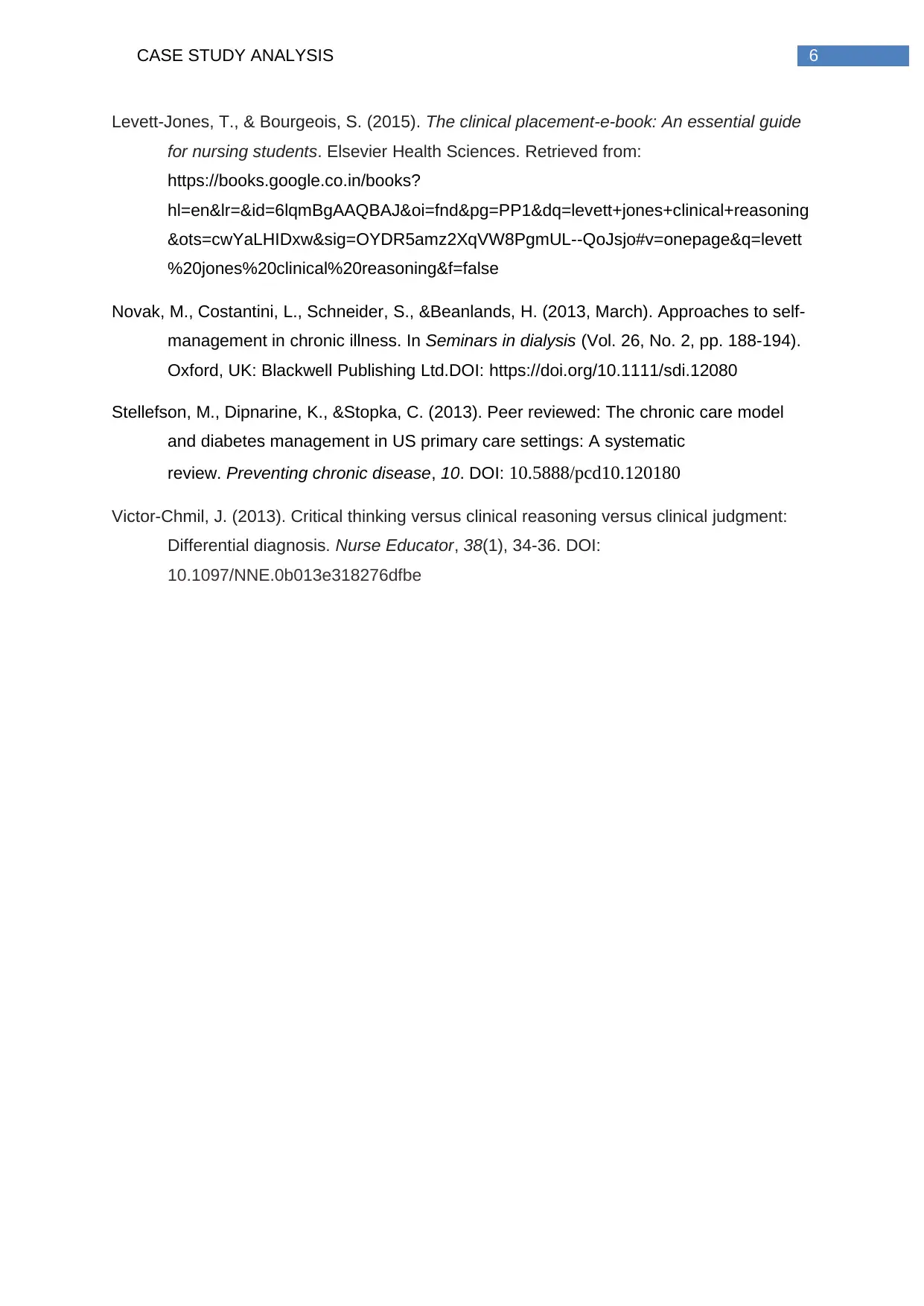
6CASE STUDY ANALYSIS
Levett-Jones, T., & Bourgeois, S. (2015). The clinical placement-e-book: An essential guide
for nursing students. Elsevier Health Sciences. Retrieved from:
https://books.google.co.in/books?
hl=en&lr=&id=6lqmBgAAQBAJ&oi=fnd&pg=PP1&dq=levett+jones+clinical+reasoning
&ots=cwYaLHIDxw&sig=OYDR5amz2XqVW8PgmUL--QoJsjo#v=onepage&q=levett
%20jones%20clinical%20reasoning&f=false
Novak, M., Costantini, L., Schneider, S., &Beanlands, H. (2013, March). Approaches to self‐
management in chronic illness. In Seminars in dialysis (Vol. 26, No. 2, pp. 188-194).
Oxford, UK: Blackwell Publishing Ltd.DOI: https://doi.org/10.1111/sdi.12080
Stellefson, M., Dipnarine, K., &Stopka, C. (2013). Peer reviewed: The chronic care model
and diabetes management in US primary care settings: A systematic
review. Preventing chronic disease, 10. DOI: 10.5888/pcd10.120180
Victor-Chmil, J. (2013). Critical thinking versus clinical reasoning versus clinical judgment:
Differential diagnosis. Nurse Educator, 38(1), 34-36. DOI:
10.1097/NNE.0b013e318276dfbe
Levett-Jones, T., & Bourgeois, S. (2015). The clinical placement-e-book: An essential guide
for nursing students. Elsevier Health Sciences. Retrieved from:
https://books.google.co.in/books?
hl=en&lr=&id=6lqmBgAAQBAJ&oi=fnd&pg=PP1&dq=levett+jones+clinical+reasoning
&ots=cwYaLHIDxw&sig=OYDR5amz2XqVW8PgmUL--QoJsjo#v=onepage&q=levett
%20jones%20clinical%20reasoning&f=false
Novak, M., Costantini, L., Schneider, S., &Beanlands, H. (2013, March). Approaches to self‐
management in chronic illness. In Seminars in dialysis (Vol. 26, No. 2, pp. 188-194).
Oxford, UK: Blackwell Publishing Ltd.DOI: https://doi.org/10.1111/sdi.12080
Stellefson, M., Dipnarine, K., &Stopka, C. (2013). Peer reviewed: The chronic care model
and diabetes management in US primary care settings: A systematic
review. Preventing chronic disease, 10. DOI: 10.5888/pcd10.120180
Victor-Chmil, J. (2013). Critical thinking versus clinical reasoning versus clinical judgment:
Differential diagnosis. Nurse Educator, 38(1), 34-36. DOI:
10.1097/NNE.0b013e318276dfbe
1 out of 7
Related Documents
Your All-in-One AI-Powered Toolkit for Academic Success.
+13062052269
info@desklib.com
Available 24*7 on WhatsApp / Email
![[object Object]](/_next/static/media/star-bottom.7253800d.svg)
Unlock your academic potential
Copyright © 2020–2025 A2Z Services. All Rights Reserved. Developed and managed by ZUCOL.





